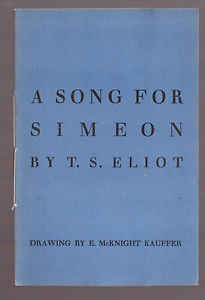
A Song for Simeon
"A Song for Simeon" is a 37-line poem written in 1928 by American-English poet T. S. Eliot (1888–1965). It is one of five poems that Eliot contributed to the Ariel Poems series of 38 pamphlets by several authors published by Faber and Gwyer. "A Song for Simeon" was the sixteenth in the series and included an illustration by avant garde artist Edward McKnight Kauffer.[1] The poems, including "A Song for Simeon", were later published in both the 1936 and 1963 editions of Eliot's collected poems.[2]
This article is about the 1928 poem by T. S. Eliot. For the Christian liturgical text known as the "Song of Simeon" or "Canticle of Simeon", see Nunc dimittis.A Song for Simeon
1928
September 1928
37
In 1927, Eliot had converted to Anglo-Catholicism and his poetry, starting with the Ariel Poems (1927–31) and Ash Wednesday (1930), took on a decidedly religious character.[3] "A Song for Simeon" is seen by many critics and scholars as a discussion of the conversion experience. In the poem, Eliot retells the story of Simeon from the second chapter of the Gospel of Luke, a just and devout Jew who encounters Mary, Joseph and the infant Jesus entering the Temple of Jerusalem. Promised by the Holy Ghost that he would not die until he had seen the Saviour, Simeon sees in the infant Jesus the Messiah promised by the Lord and asks God to permit him to "depart in peace" (Luke 2:25–35).
The poem's narrative echoes the text of the Nunc dimittis, a liturgical prayer for Compline from the Gospel passage. Eliot introduces literary allusions to earlier writers Lancelot Andrewes, Dante Alighieri and St. John of the Cross. Critics have debated whether Eliot's depiction of Simeon is a negative portrayal of a Jewish figure and evidence of anti-Semitism on Eliot's part.
"A Song for Simeon" is a 37-line poem written in free verse. The poem does not have a consistent pattern of meter. The lines range in length from three syllables to fifteen syllables. Eliot uses end rhyme sporadically in 21 lines of the poem, specifically:[1][2]
Eliot's use of lamentation, desolation and consolation—a repetition of the two-syllable -ation ending—is an example of syllable rhyme. Eliot employs forced rhyme (also called "oblique rhyme") on peace and ease (lines 8 and 11), and eye rhyme on home and come (lines 14 and 15).[1][2]
"A Song for Simeon" is structured as a first-person dramatic monologue spoken by Simeon.[20]: p.70–72 [21] Eliot's style of monologue used in the poem (and in many of his works) draws heavily from the influence of English Victorian poet Robert Browning (1812–1889).[4]: p.276 [20]: p.72 [22]: p.95 Literary scholar Martin Scofield directly identifies Simeon's recitation as "the voice of the Browningesque dramatic monologue" and characterises Eliot's use of Simeon as a speaker as a "mask that half hides and half reveals the poet".[23]: p.77